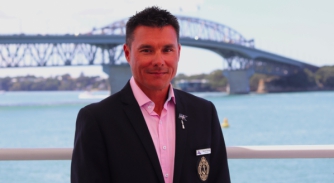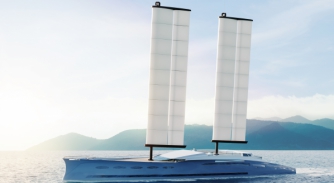Sailing ahead with Southern Spars
Mark Hauser, co-director and founder of Southern Spars, discusses the AC, carbon technology and the future of the sail…
Southern Spars are a New Zealand yachting institution, as well as a pioneer in composite manufacturing across many sectors. Its heavy involvement in the America's Cup helped drive a new wave of innovations that are emanating through the superyacht sector. Sailing superyachts themselves are evolving and growing. A sector that is underpinned by fast semi-production yachts up to 120ft, is now also seeing convention busting custom projects of immense size. Making it function as a wind-powered vessel falls largely on the shoulders of a manufacturer such as Southern Spars.
Nobody builds more, bigger than Southern Spars. Visiting its facility in West Auckland and speaking with co-director & founder Mark Hauser, was an eye-opening experience. In a two-part interview, we discuss the history and development of the technology at Southern Spars, as well as take a tour of the facility to see the production in action.
“With everything that we do, we challenge ourselves.” Starts Hauser, “We have a youngish group here, and we always have been. The team has come out of sailing, and from the start, we always wanted to be ahead of everyone else. The company has been through some changes, but that thinking is still with us.”
“To maintain that talent pool, we do a lot of work with universities and tech schools,” explains Hauser. “A lot of the team upstairs have moved through the production side of things on the floor. Many of our project managers have been with us for a long time, coming out of Americas’ Cup teams, and Volvo Ocean Race teams, it all adds to the dynamic here. We need that deep level of experience. We have had some truly massive projects here recently.”

Southern Spars is closely associated with the America’s Cup. What is less understood, is the extent to which it has worked across most of the teams simultaneously. “We became involved with Emirates Team New Zealand (ETNZ) very early on. We were also involved with the production and design of the rigs for most of the teams. The Cup itself was fantastic for us, and the rigs went through a fair amount. They were very lightweight and challenging to build. Prada dropped one because they ripped a bulkhead out, ETNZ capsized a couple of times. However, the rigs came through unscathed.”
“A lot of people think we make a large amount of money off a contract like the AC,” continues Hauser. “However, there is a lot to it. The specs change and it is constantly evolving. You end up pricing something without really knowing what you are building. It takes a lot of time and management, and the pressure really comes on with respect to timing as deliveries. That being said, it was fantastic for The Cup to be here and for the team here to see the Southern Spars branding flying past and, of course, winning it.”
Sail power must play a bigger role in a greener future for the fleet. However, as seen in The Superyacht New Build Report, the year-on-year deliveries of large custom yachts have plateaued in the last decade. The factors behind that trend are multi-layered, but a simple explanation is that the outfitting and operation of large custom sailing superyachts can be complicated, time-consuming, and expensive. Simplifying the sailing yacht systems is one of the key challenges for Hauser and the team at Southern Spars.
“We have many conversations with new-build yards where they talking about moving towards electricity or wind for their sustainability and green initiatives. And, put simply, we are the wind. Our challenge now is to develop a much simpler above deck system. We believe we have done that by working with innovative partners, such as DynaRig, and we are close to some further significant new build contracts.” Says Hauser.
“Our goal is to produce systems that give the vessel that performance, but also cuts down on the amount of above deck winches, lines and rigging,” continues Hauser “This will keep the cost down. The designers are working hard. This is our next big challenge in order to take the sailing yacht market to the next level.” The marker has been laid down by builds such as Black Pearl, and the proof of concept is there. Creating more sailing yachts that do not compromise on ease of operations and can truly take advantage of the benefits of wind power, and under sail power generation, is fundamental to a more sustainable future for the fleet.
.jpg)
Obviously, a sailing yacht goes nowhere without the sails. Despite all design precautions and preparation, a new build sailing yacht has always had a period of trial and error in the final stages of delivery, when the sail and the rig meet for the first time. Hauser explains that the technology and relationships within the sector have made huge strides in this respect. “We are always looking to make the rig/sail combination better and are working very closely with the sail markers. We now can tune the rigs before we build them. We can ensure the depth of the sails vs the bend in the rig is perfect, the headsail tensions, everything. We have race boats now that can go racing without having to touch the stays. We can put the rig in the boat, go sailing that day and start training the crew the next. This has been a huge development”
The quantum leap in rigging and mast manufacturing came with the advent of carbon rigging. The strength that it afforded, via mechanisms such as the righting moment, allowed designers and naval architects to rewrite the rule book. The next big steps are more subtle, however, as Hauser outlines “There are many small advancements taking place at once. For example, TPT (Thin Ply Technology), and pre-laminated carbon, both of which have been a significant gain for us and allowed us to take significant weight out of the tube while keeping the same strength. We have always had the philosophy that if we stop evolving and innovating then we may as well close the doors.”
“We don’t really see an upper limit to the size of these rigs, and the sailing yacht sector," concludes Hauser. “Owners want to go further, be more intrepid. And we have a capability to grow with the market.”
106.80m 15.00m 4.00m 2864
Ken Freivokh DesignNuvolari - Lenard
Ken Freivokh DesignNuvolari - Lenard
Dykstra Naval ArchitectsLateral Naval Architects
NEW: Sign up for SuperyachtNewsweek!
Get the latest weekly news, in-depth reports, intelligence, and strategic insights, delivered directly from The Superyacht Group's editors and market analysts.
Stay at the forefront of the superyacht industry with SuperyachtNewsweek
Click here to become part of The Superyacht Group community, and join us in our mission to make this industry accessible to all, and prosperous for the long-term. We are offering access to the superyacht industry’s most comprehensive and longstanding archive of business-critical information, as well as a comprehensive, real-time superyacht fleet database, for just £10 per month, because we are One Industry with One Mission. Sign up here.
Related news

The road to Barcelona for the 37th America's Cup
Aaron Young, commodore of the Royal New Zealand Yacht Squadron, looks ahead to Barcelona and discusses the decision to take The Cup north
Business

Nautor Swan reflects
Giovanni Pomati, CEO of Nautor Group, considers the last two years and the future of sailing yachts
Fleet

Baltic Yachts’ innovation creates the most sustainable sailing vessels
It all starts with the fundamentals...the little things that bring down consumption, reducing the amount of power and number of batteries required
Technology

Merveille Yachting annouces wing powered eco cruiser
When is a sailing yacht not a sailing yacht? When it's a motor yacht obviously
Technology
Related news
The road to Barcelona for the 37th America's Cup
3 years ago
Nautor Swan reflects
3 years ago
NEW: Sign up for
SuperyachtNewsweek!
Get the latest weekly news, in-depth reports, intelligence, and strategic insights, delivered directly from The Superyacht Group's editors and market analysts.
Stay at the forefront of the superyacht industry with SuperyachtNewsweek




